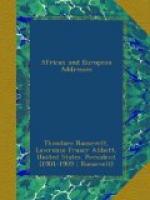When whole faunal groups die out over large areas, the question is different, and may or may not be susceptible of explanation with the knowledge we actually possess. In the old arctogaeal continent, for instance, in what is now Europe, Asia, and North America, the glacial period made a complete, but of course explicable, change in the faunal life of the region. At one time the continent held a rich and varied fauna. Then a period of great cold supervened, and a different fauna succeeded the first. The explanation of the change is obvious.
But in many other cases we cannot so much as hazard a guess at why a given change occurred. One of the most striking instances of these inexplicable changes is that afforded by the history of South America towards the close of the tertiary period. For ages South America had been an island by itself, cut off from North America at the very time that the latter was at least occasionally in land communication with Asia. During this time a very peculiar fauna grew up in South America, some of the types resembling nothing now existing, while others are recognizable as ancestral forms of the ant-eaters, sloths, and armadillos of to-day. It was a peculiar and diversified mammalian fauna, of, on the whole, rather small species, and without any representatives of the animals with which man has been most familiar during his career on this earth.
Towards the end of the tertiary period there was an upheaval of land between this old South American island and North America, near what is now the Isthmus of Panama, thereby making a bridge across which the teeming animal life of the northern continent had access to this queer southern continent. There followed an inrush of huge, or swift, or formidable creatures which had attained their development in the fierce competition of the arctogaeal realm. Elephants, camels, horses, tapirs, swine, sabre-toothed tigers, big cats, wolves, bears, deer, crowded into South America, warring each against the other incomers and against the old long-existing forms. A riot of life followed. Not only was the character of the South American fauna totally changed by the invasion of these creatures from the north, which soon swarmed over the continent, but it was also changed through the development wrought in the old inhabitants by the severe competition to which they were exposed. Many of the smaller or less capable types died out. Others developed enormous bulk or complete armor protection,




